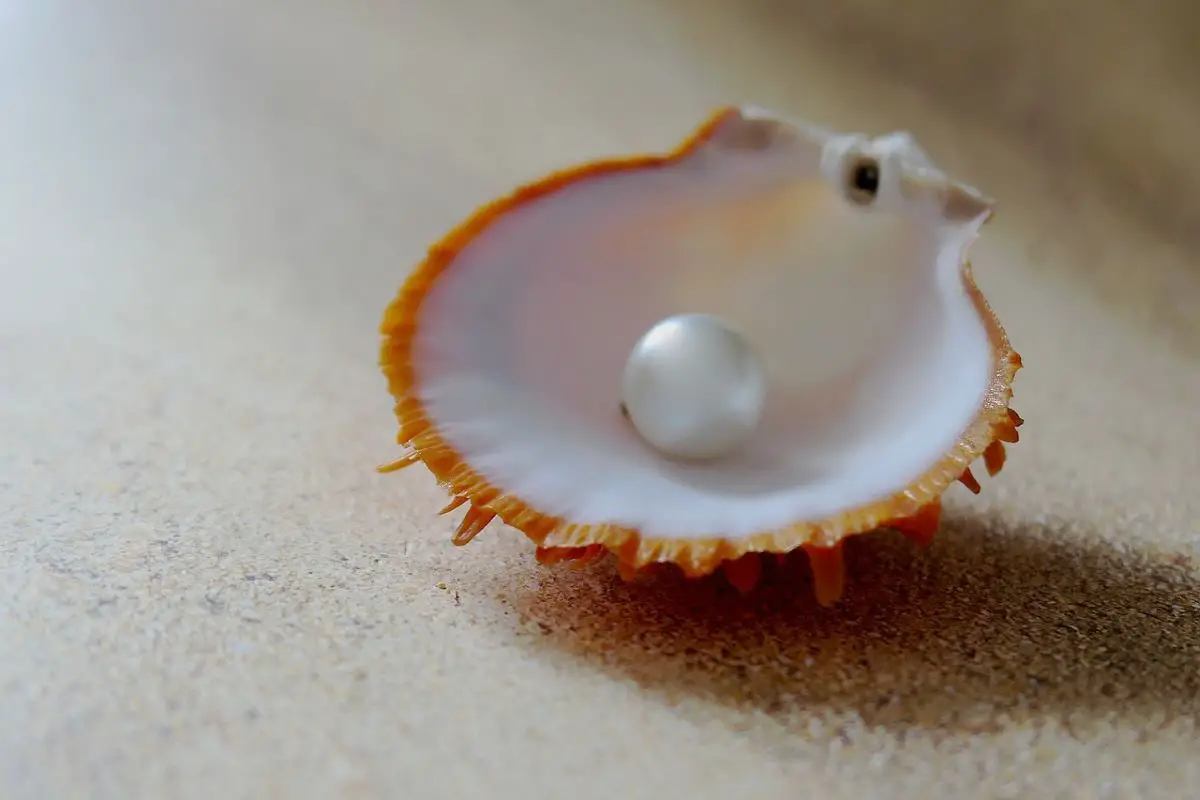Pearls are hard, glistening objects which form within the soft tissues (specifically the mantle) of living shelled mollusks or animals like fossil conulariids. A pearl is comprised of minute crystalline calcium carbonate (mostly aragonite or aragonite with some calcite) in concentric layers, just like the shell of a mollusk.
Pearls are usually round and smooth, but they can come in many shapes, such as baroque pearls. Since ancient times, natural pearls have been admired as gemstones and pieces of art. A pearl is therefore considered to be something rare, precious, admirable, and fine, admirable.
In this article, we will discuss everything about pearls, including their origin, formation and how they are harvested. Let’s first take a look at their origin.
What Is The Origin Of Pearls?
The simplest answer to this question would be ‘nature’. Pearls grow inside different ocean creatures like mollusks and oysters. Oysters and mussels may not seem like living creatures, but they are. Mussels are freshwater mollusks, while oysters live in the ocean.
It takes many years for either of these creatures to produce pearls. The finished product we wear is the result of those many years.
Pearls are among the earth’s most beautiful and valuable natural treasures. Since ancient times, humans have valued them and they were significant, even in ancient civilizations like Ancient Egypt and Ancient Rome. Therefore, pearls remain one of the most popular jewelry choices today. Their timeless aesthetic makes them a quintessential gemstone jewelry piece.
How Are Pearls Formed
A pearl can essentially be classified into three types: natural pearls, cultured pearls, and imitation pearls. A natural pearl (often referred to as an Oriental pearl) is formed when an irritant enters a specific species of oyster, mussel, or clam. The mollusk coats the irritant with fluid as a defense mechanism. This coating is deposited on the irritant layer by layer until a lustrous pearl is formed.
Cultured pearls go through a similar process. The only difference between the two is that the irritant is a surgically implanted piece or bead of shell known as Mother of Pearl. This shell is often ground oyster shell, which contributes significantly to the price of quality pearls in their own right as catalysts for irritants. Consequently, the core of a cultured pearl is much larger than a natural pearl. However, it is not the size of the nucleus that determines how beautiful or durable a pearl will be, but the number of layers of nacre (the secreted fluid covering the irritant).
Pearls can have either salt or freshwater sources. Normally, saltwater pearls will be of higher quality, but there are several types of freshwater pearls that are also highly valued. Typically, freshwater pearls have quite irregular shapes, resembling puffed rice. However, it is the merits of each pearl that determine the value, not its origin.
Pearls are usually acquired through several years-long processes, regardless of the method used to acquire them. A mature mussel must reach maturity, which can take up to three years, before being implanted or receiving an irritant. It can take another three years for the pearl to reach full size after the irritant is in place. Frequently, the irritant is rejected, the pearl turns out to be very misshapen, or the oyster dies from disease or many other complications. Only half of the oysters will survive at the end of a 5- to 10-year cycle. There are only about 5% of pearls that are of a quality that is suitable for jewelry makers. In the beginning, a pearl farmer will spend over $100 for every oyster they farm, many of which will not produce pearls or die.
Imitation pearls are a whole other story. In most cases, glass beads are dipped into a solution made of fish scales. However, the coating may eventually wear off because it is very thin. Did you know you can easily find out an imitation pearl by biting it? Yes, false pearls tend to glide on your teeth. On the other hand, the layers of nacre present on real pearls feel a bit gritty. The Island of Mallorca is famous for its imitation pearl industry.
How Are Pearls Harvested?
The next step is to remove the pearl from the mollusk once it has fully formed and is large enough to be harvested. The process of harvesting pearls requires precision, care, and expert knowledge. The mollusk is first gently opened, just enough for the pearl to be retrieved. Afterward, the pearl is carefully removed with specially adapted surgical instruments. The removal process should be conducted in a way that does not harm the mollusk in any way. The mollusk will be used to produce another pearl if the harvested pearl is of premium quality. Once a pearl has been harvested, its final step is to be prepared for jewelry.
Do Oysters Die When You Take Out the Pearl?
When the farmer takes out the pearl from the oyster, it does not harm or kill it, however, it should be harvested extremely carefully.
How Do You Find Out If An Oyster Contains A Pearl?
An oyster does not show any obvious signs that it contains a pearl. The only way to find out whether there is one inside the shell is to open it. Older and larger oysters, however, have a higher probability of containing pearls.
Can Oysters Produce Colored Pearls?
Yes, oysters can produce colored pearls. They come in a variety of colors, which include black, white, red, green, blue, and gray. Most of these colors are found in oysters all across the globe, but black pearls, specifically are indigenous to the South Pacific.
Conclusion
Now that you know what pearls are made of and how they are made, you would know why it is so valuable. For the perfect pearl to form, the circumstances have to be right. Moreover, they take about 5-10 years to be ready before they get harvested. So the next time you go shopping for pearls or any pearl jewelry, remember how precious gems they are in the gemstone world!
You May Like These Articles As Well:
 Being Human
Being Human





